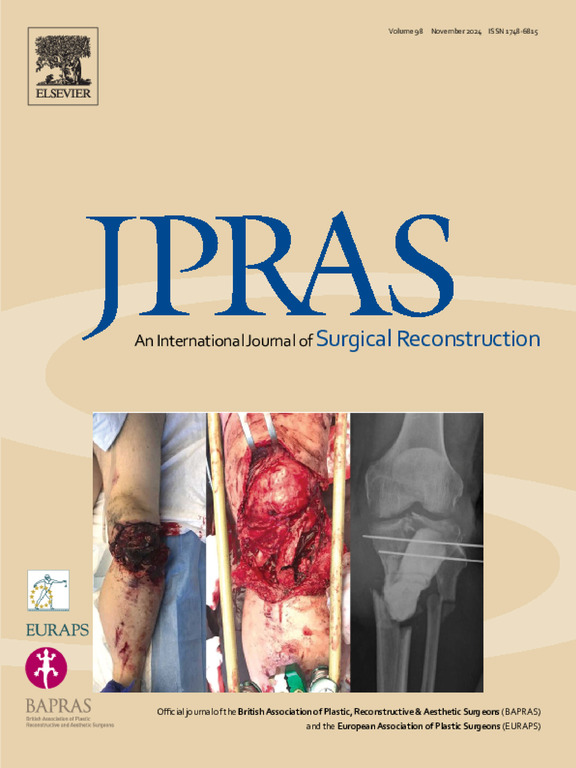Hormonal status and gender identity do not change aesthetic preferences for top surgery
IF 2
3区 医学
Q2 SURGERY
Journal of Plastic Reconstructive and Aesthetic Surgery
Pub Date : 2025-01-01
DOI:10.1016/j.bjps.2024.11.043
引用次数: 0
Abstract
Background
Chest masculinization surgery (CMS) is becoming increasingly common, especially in the nonbinary population. However, variations in CMS preferences between this group and the transgender population remain undefined. Additionally, it is unknown if concurrent testosterone use may correlate with differing aesthetic preferences. Therefore, we aimed to identify whether aesthetic preferences vary among patients undergoing CMS based on gender identity and hormonal treatment status.
Methods
Patients undergoing masculinizing top surgery participated in an institutional survey identifying their aesthetic preferences through two modified photos representing normal and high BMI. A total of 115 patients completed the survey with 98 non-binary and transgender male patients meeting inclusion criteria. Patients were compared by gender and hormonal status.
Results
Among participants, 32 were non-binary on hormonal therapy, 33 were non-binary without hormonal therapy, and 33 were transgender males on hormonal therapy. Comparisons among transgender males on hormonal therapy and non-binary individuals on and off hormonal therapy revealed no differences in preferences for mean nipple diameter for an example individual with a normal BMI (P=0.64) or an example individual with a high BMI (P=0.42). Preference for the straight scar type remained consistent across all groups for both normal (P=0.88) and high BMI (P=0.28) examples.
Conclusions
Despite our study population’s diversity, hormonal status and gender identity did not correlate with aesthetic preferences. Individual aesthetic preferences should not be implied by gender identity or hormone status and instead may be better understood with a more systematic and collaborative decision-making process.
荷尔蒙状况和性别认同不会改变对顶部手术的审美偏好。
背景:胸部男性化手术(CMS)变得越来越普遍,特别是在非二元人群中。然而,这一群体和跨性别人群在CMS偏好方面的差异仍不明确。此外,是否同时使用睾酮可能与不同的审美偏好有关尚不清楚。因此,我们的目的是确定在接受CMS的患者中,基于性别认同和激素治疗状况的审美偏好是否存在差异。方法:对接受男性化顶手术的患者进行问卷调查,通过BMI正常和BMI高的两张修改后的照片来确定患者的审美偏好。共有115名患者完成了调查,其中98名非二元和跨性别男性患者符合纳入标准。比较患者的性别和激素状况。结果:接受激素治疗的非二元男性32人,未接受激素治疗的非二元男性33人,接受激素治疗的变性男性33人。在接受激素治疗的跨性别男性和接受或不接受激素治疗的非二元性别个体之间的比较显示,正常BMI个体(P=0.64)和高BMI个体(P=0.42)对平均乳头直径的偏好没有差异。对于正常(P=0.88)和高BMI (P=0.28)的样本,所有组对直型疤痕的偏好保持一致。结论:尽管我们的研究人群具有多样性,但荷尔蒙状况和性别认同与审美偏好无关。个人的审美偏好不应该被性别认同或激素状态所暗示,相反,通过更系统和协作的决策过程可以更好地理解。
本文章由计算机程序翻译,如有差异,请以英文原文为准。
求助全文
约1分钟内获得全文
求助全文
来源期刊
CiteScore
3.10
自引率
11.10%
发文量
578
审稿时长
3.5 months
期刊介绍:
JPRAS An International Journal of Surgical Reconstruction is one of the world''s leading international journals, covering all the reconstructive and aesthetic aspects of plastic surgery.
The journal presents the latest surgical procedures with audit and outcome studies of new and established techniques in plastic surgery including: cleft lip and palate and other heads and neck surgery, hand surgery, lower limb trauma, burns, skin cancer, breast surgery and aesthetic surgery.

 求助内容:
求助内容: 应助结果提醒方式:
应助结果提醒方式:


